
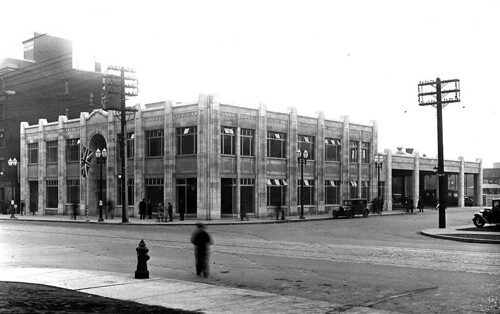
Motor coach terminal, Bay and Edward streets, Toronto, December 19, 1931. City of Toronto Archives, Fonds 16, Series 71, Item 9041.
When intercity bus travel arrived in Toronto during the 1920s, passengers had to make due with open air terminals that offered little in terms of comfort. The growth of the Toronto Transit Commission’s Gray Coach Lines division fuelled the need for a permanent structure to provide services to weary travellers. On December 19, 1931, local and provincial dignitaries gathered to officially open the Gray Coach Terminal (now the Toronto Coach Terminal) for passenger service, with a promise that the doors would be open at all hours of the day.
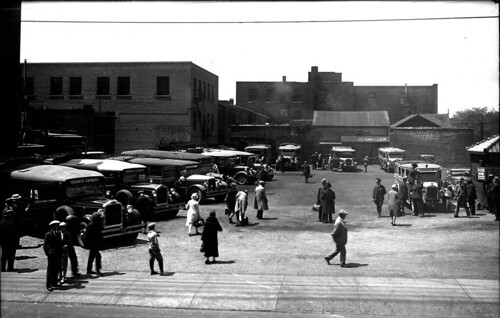
Dundas and Bay, Gray Lines Terminal, June 16, 1928. City of Toronto Archives, Fonds 16, Series 71, Item 5943.
The terminal was built on the site of an existing open-air depot at the southwest corner of Bay and Edward. Construction appears to have been rapid—the preliminary layout of the building was made on site in April 1931, but pictures taken two months later revealed little progress. By December, the finishing touches were made and photographers were allowed to snap away before the first passengers arrived.
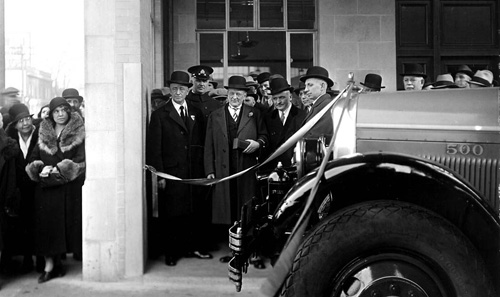
Acting Premier, Attorney-General Price, severing silk tape that officially dispatched the first coach from the Bay St motor coach terminal, December 19, 1931. City of Toronto Archives, Fonds 16, Series 71, Item 9029.
The official ceremony was held at 12:30 p.m. Attorney-General W.H. Price, standing in for Premier George Stewart Henry, cut the ribbon. Mayor William James Stewart proceeded to buy the first ticket, a return trip from Hamilton. After half-an-hour of speeches, passengers boarded the first bus to the Steel City and were seen off by Price. “It must have been a surprise,” noted the Globe, “to see a gentleman poke his head into the coach and on behalf of the province of Ontario wish all and sundry a Merry Christmas and add that he hoped their lives would be a pleasant as the bus and last as long as the new terminal.”
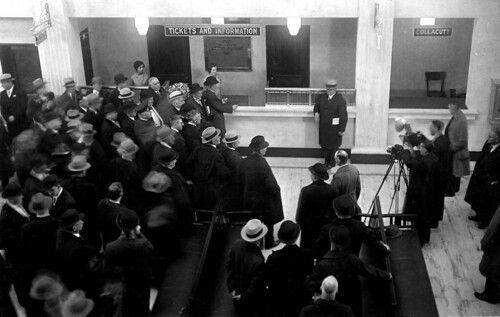
Mayor William James Stewart purchasing first ticket issued at opening of Bay St motor coach terminal, December 19, 1931. City of Toronto Archives, Fonds 16, Series 71, Item 9030.
Mayor Stewart and TTC chairman William C. McBrien also poked their heads on the bus. “Then, the wide-eyed and disconcerted passengers were about to comment on this new policy of the Queen City in giving a big send-off to visitors, the bus lurched forward and the crowd of city fathers and leading citizens without burst into a mighty cheer. And the passengers lapsed back into silent awe, wondering if Rudy Vallee was in their midst. He wasn’t. Neither was Babe Ruth.”

Motor coach terminal, Bay and Edward streets, Toronto, North Mezzanine, looking west – December 19, 1931. City of Toronto Archives, Fonds 16, Series 71, Item 9035.
Dignitaries boarded another bus bound for a roof garden luncheon at the Royal York Hotel. The head table was designed to resemble a miniature highway, complete with buses and road signs. McBrien opened the lunch with a thanks to city council for its support of the project, noting how its development had been free of political rancor—”You have treated us as men and we appreciate it very much.” Stewart noted how proud he was to be McBrien’s friend—”You have given fearless and sane administration. While it has been my privilege to be a friend of yours, you have not endeavoured to use friendship to dictate actions to me.” Price admitted his initial opposition to the TTC’s control of the terminal, due to fears of a monopoly, and urged co-ordination between all agencies running the modes of transportation used in the city (rail, truck, boat, etc).
Sources: the December 19, 1931 edition of The Telegram and the December 21, 1931 editions of The Globe and The Mail and Empire.

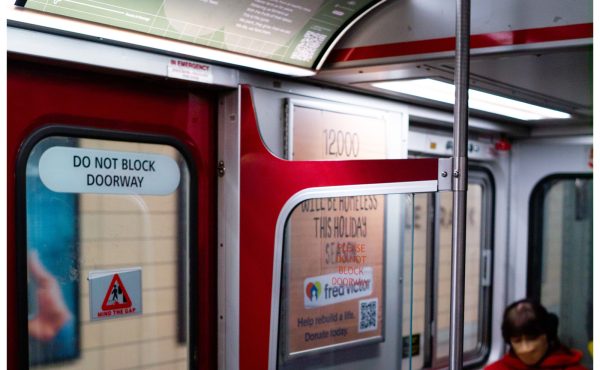


14 comments
Excellent essay, thank you. I’ve always loved this building but felt it was under-appreciated. What an interior!
Of course, I fully support getting the buses the hell out of this location since it is no longer a functional spot for them. Move the buses to the GO Union terminal and then come up with a terrific adaptive reuse of the 1931 building for other purposes.
It’s too bad you are no longer allowed on the second level
The last time I had occasion to be in the terminal, about a year ago, it looked like a little effort had been put into making it more welcoming but on the whole it has a depressing ambience.
Roll on a morning train to Kitchener – by GO, VIA, anybody so long as I don’t have to use Greyhound. Move the coaches to Harbour Street with the GO buses and let’s figure out how to make the most of this building.
Where did you get the photos from? I’d like to upload them to Wikipedia, but higher-resolution versions would be nice.
Wow. How the mighty have fallen. I had no idea it looked so nice, once.
Thanks for this essay:
A few years ago I traveled US on the Greyhound system. Of the 15 or so terminals I visited, Toronto’s proved by far the best. In fact, I would argue it’s the ‘Grand Central Station’ of bus terminals.
There is, I think a good argument for the terminal remaining a Greyhound station.
First, the cultural value in maintaining the original use of this historic building is really important. That terminal as a working building is gives it more cultural value then closing its doors ‘restoring it’ to an architectural ideal. Its cultural value lies in the building’s use and social associations, not primary its architectural design. Such rare buildings, which reflect a common experience and remind ‘living heritage,’ are the type we should keenly work to protect.
Secondly, we should remember that the current station is only a few subway stops from Union, between the two north-south subway lines, and near a pair of east-west street car routes. It is at the core of the city – just where transportation services should be. Moving it to Union would save a bit of time for transfers to the GO, Via, or the future airport link.
However, realistically, would someone take a Greyhound down the DVP to Union station Toronto in order to get up to Pearson? The cost saving over a a direct airport van service would be minimal in relation to the added complexity and time of this the trip. Besides, the cost of getting to the airport by van is marginal compared to whole cost of any trip involving a flight.
Thirdly, the fact the bus terminal does not fit neatly with its surroundings contributes to the character of Toronto’s downtown.
The city only becomes less interesting as activities are herded together in neat zones where we put traveling here, shopping there, over there a place a sleep, and down there, for work. The vitality of Toronto is not just its cultural mishmash but its juxtaposition of urban activities. A city resembling a TV dinner will be just as bland.
Lastly – and I do mean this – the terminal is a place I enjoy. It is for more interesting and friendly then say, Pierson, Union Station, or the labyrinth at Young and Bloor. Even with engine fumes and pigeons crapping on there rafters, it has a special vibe.
Buildings that lend respect and meaning to mass transit are important if there is to be a popular shift away from car culture. Part of this is a wider respect for the culture of bus travel; and I know that a big part of bus culture here in the city is our ‘Grand Central’ terminal.
Ok. Thanks for reading and enjoy your trip!
George, all of your points are excellent, except for the fact that buses can no longer get to the terminal due to congestion. Traffic patterns are not what they were in 1931.
The Port Authority Bus Terminal in New York is a complete mess but cultural or streetscape arguments for what to do with it are academic — the building will never be rebuilt elsewhere because it has excellent infrastructure providing direct bus-only lanes into the Linconln Tunnel. In short, it functions brilliantly. If there was a magic tunnel or skyway that dropped buses from the DVP or Gardiner onto Bay and Dundas, it would be fine to leave the terminal in operation. I just don’t see the point in wasting 20 min for every trip due to trying to force bus traffic up narrow downtown streets. There is also the disconnect between Greyhound and GO/TTC that wastes time for transferring passengers.
Keeping the bus terminal inefficient lowers the appeal of taking the bus, which reduces demand, which degrades the terminal experience, etc.
I’m with George. Leave the Bus Terminal a Bus Terminal.
Where would you put all those Greyhounds and Coach Canada buses at the GO terminal???
Have you been down there at midday or in the evenings? The GO buses barely all fit in there and it’s totally jammed, plus there’s nowhere to expand it unless another terminal is built elsewhere.
Great pics, great essay and a good discussion.
I really appreciate the heritage use discussion led by George Martin above.
As a neighbour in a nearby office tower I do have to agree that the city’s growth and the growth of bus traffic have impacted the efficiency of this location.
I should also note that the size of the buses has changed quite dramatically since 1931. Heck, they look like extended cars.
Currently the majority of long distance buses either head east along Dundas (through Yonge) to get to the DVP or take Armoury over to University and then spend 20 – 30 minutes trying to get to the Lakeshore or Gardiner with all the other traffic downtown.
In order to beat all this traffic I believe the review of the idea of shifting the terminal to the area of the OPP building down by the Lakefront at 90 Harbour Ave – south of the Air Canada Centre and north of Queen’s Quay is heating up.
(More background at: http://transit.toronto.on.ca/archives/data/200812220430.shtml) While this would be terrible for riders (or not) who prefer to land right in the middle of the city it would go a long way towards reducing street congestion and pollution in the downtown core.
So what to do with the terminal if this happens? How about this – sell the 70’s concrete addition west of the station in these pics (between Elizabeth and Chestnut) and use the funds to restore the station to its origal 1931 glory and use the in-station bus bays for local tour buses and Niagara Falls tour buses. In this way, the city would celebrate its many offerings, reduce congestion and pollution and hang onto a functioning, but newly repurposed bus terminal. Heck we could call it “Transformation Bus Terminal”. I can see the buskers now.
Waddya think?
Wow, thanks Jaime! Great history lesson and spectacular photos from the archives.
It really is a shame that attention to detail in today’s architecture doesn’t take notes from the past. And we’ve also got to say that maintanence and keeping ones charm of “some” historical landmarks in this city obviously aren’t being met. Shame on the city for that one.
I’ll have to agree with uSkyscrapper on this one. The current location for this terminal is dreadful. Not only for the buses, navigating their way thru traffic, but us “riders” who have to walk a bit of a way, from the subway, thru corridors, doors and stairs, to get to the terminal.
Why “not” move it closer to Union and GO stations?? Does it not make more sense? Less traffic, closer to the Gardiner or DVP…
People’s complaint of “space” by the GO station shouldn’t be an issue. Simply expand that bus station.
*Oh but wait…. Josh and Shawn love their condos being built by Union/ACC(*I had to throw that in there guys, sorry, haha 🙂
To add, the old station on Bay and Edwards should defenitely be preserved. Is it not a historical site?
Dabusan: Good suggestition to sell the 70’s western extention to renovate the original building. Any money to help restore that origianal to it’s beautfil self, would always be a good idea.
Maybe convert it to a transport museum? Does Toronto have one of those?
Wow. Amazing! What a difference. I had no idea the terminal once looked so lovely and elegant. Today it’s crowded and depressing.
Actually, it was more “crowded and depressing”–albeit paradoxically more “authentic”–before its rehabilitation about 20 years ago, which opened up the ground level waiting area into the bus bays while restoring many of the older elements. (The upper level was reopened to the public this time; but it didn’t work out and the space was subdivided into offices–the present ground-level Kramden’s Kafe is a pale, reduced shadow of what they hoped for up there.)
Any lack of elegance now owes more to what’s happened to bus travel than to what’s happened to the terminal.